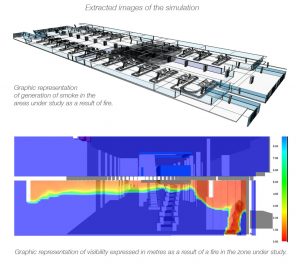Among the many difficulties posed by the design of airport passenger terminals, perhaps one of the most important, and yet at times forgotten, is their design from a fire protection standpoint.
In Spain, the Technical Building Code (Código Técnico de la Edificación – CTE) establishes the legal framework for fulfilling the basic requirements required for building fire protection matters. It provides a rigid set of rules and procedures which are set out in a document entitled Documento Básico de Seguridad Contra Incendios (Basic Fire Protection Safety Document), which define parameters like maximum evacuation route lengths or the maximum dimensions of fire sectors that have to be valid for all kinds of buildings. However, what happens at a passenger terminal where the sectors’ surface areas often exceed the maximum limits set forth in the rules? Or how can the evacuation of occupants be combined without affecting the airport’s operability and safety?
 Fortunately, Article 5.1 of the CTE itself allows a building’s safety conditions related to fire protection matters to be justified through alternative solutions.
Fortunately, Article 5.1 of the CTE itself allows a building’s safety conditions related to fire protection matters to be justified through alternative solutions.
Our experience at airports has led us to recommend conducting a fire protection analysis on the building based on effectiveness and service provision. A set of specific measures geared at safeguarding human life without forgetting the airport’s operation are therefore created. In order to achieve this, the Handbook of Fire Protection Engineering drawn up by the Society of Fire Protection Engineers provides a methodology that defines the sequence of steps which should be followed to ensure the goals set as objectives are reached.
For instance, people having enough time to reach exits without being dangerously affected by the effects of a fire is put forward to justify the safe evacuation of occupants. A prior analysis of passenger types and their speed of movement, the building’s actual occupation level, the fire’s detection time and the time it takes for a passenger to get ready to proceed with the evacuation should be analysed beforehand. Simulation programs are then used to calculate the total time it would take to evacuate the occupants.
The time available for the evacuation is simultaneously calculated by using a computational fluid dynamics model to simulate the fire’s generation. The time at which the environment would reach temperature, smoke, radiation, CO concentration and visibility levels which are incompatible with the safety of people can thus be estimated. Lastly, both values are compared in order to determine whether or not the evacuation is safe. Should it not be safe, solutions are set out which are in turn included in a new process of simulations until all the deficiencies are finally corrected.
We have recently applied this method to a terminal with a surface area measuring 80,000 m2. A redefinition of evacuation lengths was done, the smoke control system was redesigned, the installation of sprinklers was assessed and a tailored fire protection solution was created for the terminal throughout the process. All these measures generated savings amounting to €1.8 million whilst ensuring the safety of people at all times.



